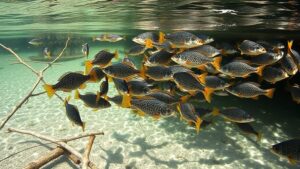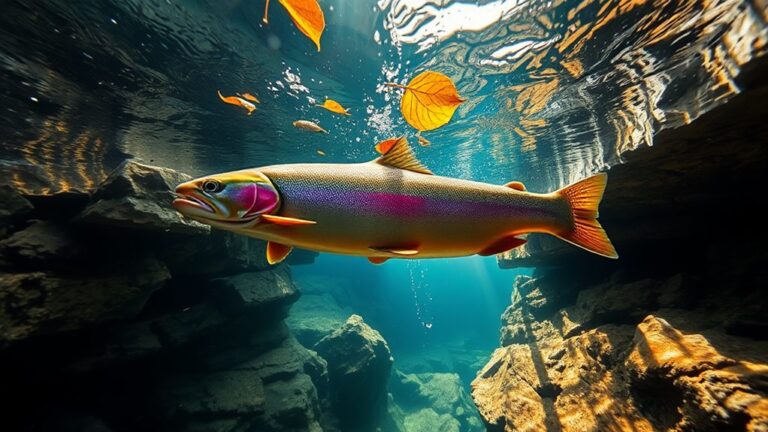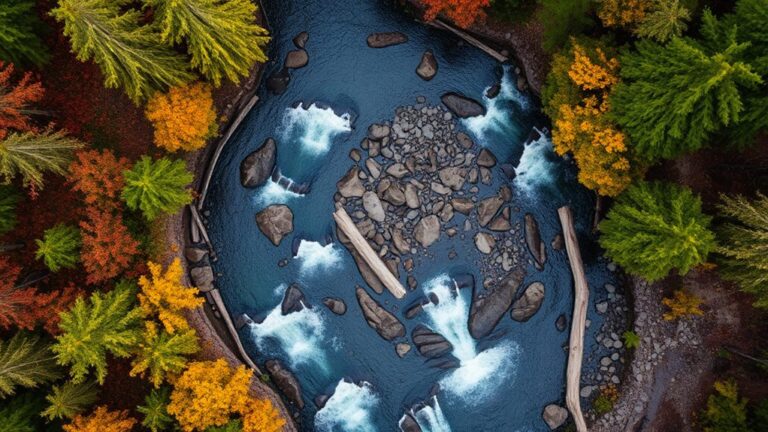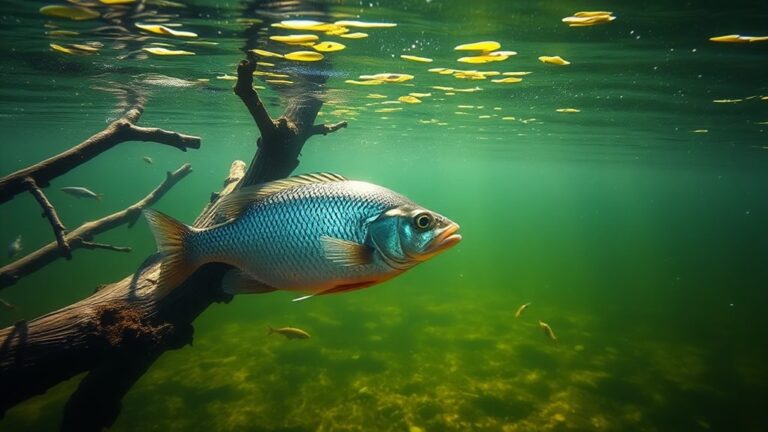Crappie move to shallow waters in spring due to a perfect combination of warming temperatures and spawning instincts. You'll find these fish heading to shallower areas once water temperatures hit the mid-50s°F, with males leading the migration. They're drawn to these areas for several key reasons: ideal spawning conditions, abundant feeding opportunities, and protection from larger predators. The warmer, well-lit shallows also attract baitfish and provide excellent visibility for hunting. Protected coves and creek backs offer prime spawning locations where males can guard their nests effectively. There's much more to understand about their fascinating shallow-water behavior.
Seasonal Migration Patterns
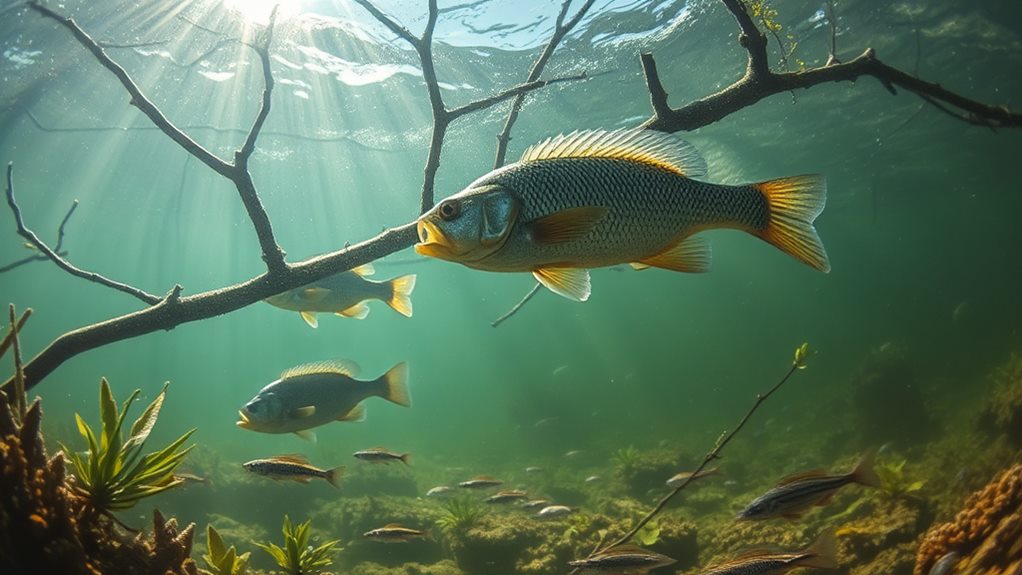
Understanding crappie migration begins with their predictable spring movement to shallow waters. As winter fades and temperatures rise, you'll notice these fish following a remarkably consistent pattern that's driven by their spawning instincts and the warming of their habitat.
The migration unfolds in stages, with male crappie leading the charge to shallow water once temperatures reach the low 60s. You'll find them actively preparing for the spawning season, while females remain in deeper waters until conditions are just right.
When water temperature climbs to the mid-60s, the females join the males, creating a surge of activity in shallow areas. This seasonal movement isn't just about reproduction – it's also about feeding opportunities. Shallow waters warm more quickly in spring, attracting various prey species that crappie depend on.
You can track this migration pattern by monitoring water temperatures, knowing that the spawning activity peaks above 70°F and can last several weeks. Once spawning concludes, you'll observe these fish gradually returning to deeper waters, completing their seasonal cycle until next spring's migration begins anew.
Water Temperature Sweet Spots
Water temperature serves as nature's thermostat for crappie behavior, with specific ranges triggering their most active periods. You'll find that male crappie make the first move to shallow areas when waters reach the mid-50s°F, while females aren't far behind, following once temperatures hit the lower 60s°F. These temperature ranges create perfect conditions for successful crappie fishing.
Here's a quick guide to crappie movement based on water temperature:
| Temperature | Fish Move | Best Fishing Areas |
|---|---|---|
| Mid 50s°F | Males Only | Near Shore Structure |
| Lower 60s°F | Both Genders | Shallow Feeding Zones |
| Above 60s°F | Active Feeding | Grass Beds & Rocks |
| 70°F+ | Spawning Time | Nesting Areas |
| Fluctuating | Unpredictable | Deep Water Refuges |
When you're planning your fishing trips, pay special attention to spawning areas with dark bottoms, grass, and rocks. These features help maintain warmer temperatures, even when surrounding waters are cooler. Remember that stable water temperatures are essential for consistent fishing success, as sudden changes can drive crappie back to deeper waters.
Prime Spawning Locations
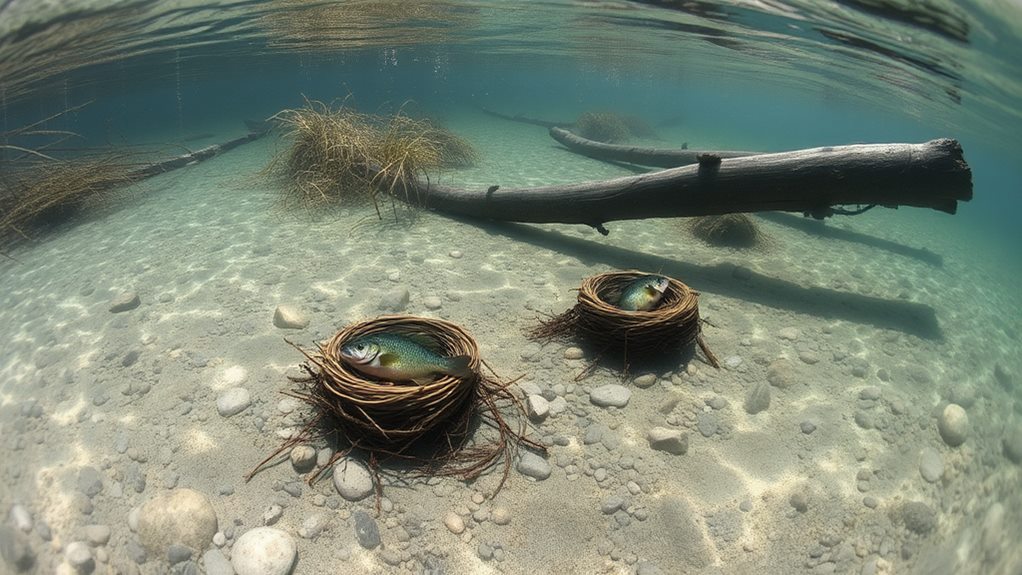
Building on these temperature patterns, successful crappie fishing depends heavily on identifying prime spawning locations. When water temps reach that magical 60°F mark, you'll find these fish gravitating toward specific shallow areas that offer the perfect combination of protection and stability for their eggs.
To maximize your success in finding these prime locations, focus on these key spawning hotspots:
- Protected coves and creek backs where the water remains consistently warmer and calmer than main lake areas.
- Areas featuring rocky bottoms or hard sand substrate, which provide ideal conditions for egg protection.
- Sheltered spots away from heavy river currents and wind-blown banks, typically in 10-15 feet of water.
- Flats with dense cover and hard bottoms, where male crappie prepare their spawning beds.
You'll notice that male crappie are the first to arrive in these shallow areas, diligently preparing the spawning beds for females.
Once the females arrive, they'll quickly deposit their eggs and retreat to deeper waters, while the males stay behind to guard the nests. Understanding this behavior pattern is essential for targeting these fish during the spawn.
Following The Baitfish
Instinct drives crappie movements in shallow waters, and nothing triggers their migration more predictably than the presence of baitfish.
You'll find these fish following their favorite prey into warmer, shallower areas as spring temperatures climb into the mid-50s. It's like nature's dinner bell, calling both predator and prey to the shallows.
When you're tracking crappie movements, keep an eye on the surface activity of shad and other baitfish. These small fish congregate in shallow areas where the water warms first, and the crappie aren't far behind.
During spawning season, as temperatures push past 70°F, you'll notice crappie becoming particularly aggressive in their pursuit of these tasty morsels.
The shallow water environment provides perfect hunting grounds, especially around structure.
Fallen trees, rocks, and grass beds create natural sanctuaries where baitfish gather, and smart anglers know these spots are prime locations for finding hungry crappie.
When you spot clusters of baitfish darting near the surface or around structure, you can bet there are crappie nearby, ready to ambush their next meal.
Sheltered Nesting Areas

During the spawning season, crappie seek out nature's most protected shallow waters for their nesting sites.
You'll find these fish spawning in quiet areas like creek arms and shallow bays, where they can safely lay their eggs away from strong currents and predators. Similar to how bass seek cover for ambush hunting, these sheltered spots provide the perfect environment for successful reproduction, especially when the water temperature reaches the low 60°F range.
When you're fishing for spawning crappie, look for these key characteristics in their chosen nesting areas:
- Protected pockets and coves that shield eggs from harsh environmental conditions
- Hard bottom surfaces, typically rocky or sandy, at depths of 10-15 feet
- Natural structure like fallen trees and brush piles that provide crucial cover
- Calm waters away from windblown banks and heavy current flow
As crappie move into these sheltered areas, they're looking for spots that offer both protection and stability.
The combination of proper depth, suitable bottom composition, and available cover creates the ideal environment for their spawning activities.
You'll notice that these fish are particularly drawn to areas where multiple favorable conditions overlap, making these spots prime locations for successful reproduction.
Light Penetration Benefits
Light penetration in shallow waters plays a key role beyond just providing safe spawning grounds.
When you're trying to understand crappie behavior, you'll notice these fish take full advantage of the increased visibility that comes with clearer, shallower waters. The enhanced light conditions make it easier for them to spot and catch their favorite prey, including small minnows and other baitfish.
As the temperature gets warmer in spring, you'll find crappie moving to these well-lit shallows where they can both feed and prepare their nesting sites. The improved visibility isn't just about hunting – it's also essential for successful spawning, as the fish need to carefully monitor their eggs.
You'll notice that shallow waters offer a perfect combination of benefits: better light penetration for hunting, warmer temperatures for comfort, and clear visibility for reproduction.
The increased light also promotes the growth of aquatic vegetation, creating a natural cycle. These plants attract smaller fish, which in turn draw in the crappie.
It's like nature's own buffet system, where everything connects through the power of light!
Feeding Opportunities In Shallows
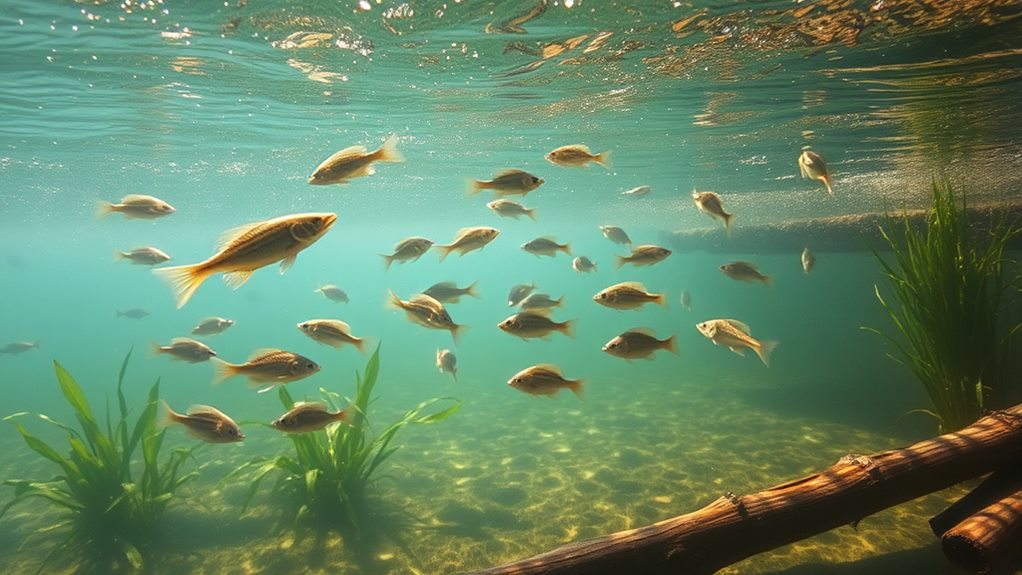
Spring's warming waters trigger crappie to venture into the shallows, where abundant feeding opportunities await them.
You'll find these fish taking advantage of the warmer shallow waters, which naturally attract schools of baitfish. Similar to rainbow trout habitats, the temperature range plays an essential role in fish activity and feeding patterns. As water temperatures climb into the low 60s°F, both predator and prey become more active, creating perfect conditions for feeding.
If you're looking to understand when crappie are most likely to be feeding in shallow waters, here are the key patterns to remember:
- Evening hours just before dark offer peak feeding activity
- Sunny days increase shallow water feeding as temperatures rise
- Early spring brings concentrated schools of both crappie and baitfish
- Pre-spawning periods see increased feeding as fish prepare for reproduction
The combination of warming temperatures and spawning instincts creates a perfect storm of feeding opportunities in shallow areas.
You'll notice crappie gathering in schools, making it easier for them to target concentrated groups of baitfish. This schooling behavior isn't just convenient for the crappie – it's also great news for anglers who can find multiple fish in one productive spot.
Protection From Predators
Seeking safety from larger predators, crappie instinctively move to shallow waters where abundant cover provides critical protection.
Similar to prime bass locations, you'll find crappie utilizing docks and submerged vegetation as key sanctuary areas. You'll find these fish gravitating toward areas with fallen trees, dense vegetation, and brush piles, especially during the spawning season when they're most vulnerable.
In shallow waters, crappie can effectively protect their nests from larger fish that might otherwise feast on their eggs. You'll notice they're particularly drawn to spots where weeds and submerged structures create natural barriers against unwanted visitors.
These hiding spots aren't just about staying safe – they're also perfect ambush points for catching smaller baitfish.
During warmer months, you'll discover crappie hanging around shallow areas that offer both protection from predators and prime feeding opportunities.
They're quite strategic about it, really – choosing locations where bigger fish can't easily maneuver. The combination of vegetation and structural cover creates a safe zone where these clever fish can thrive without constantly looking over their shoulders (figuratively speaking, of course).
It's a brilliant survival strategy that serves them well throughout the year.
Warmer Water Advantages

The shift to shallow waters offers crappie significant temperature advantages during the spring months. When water temperatures reach the low 60°F range, you'll find these fish moving to warmer, shallower areas that heat up faster than deeper waters.
This warming effect creates favorable conditions for both feeding and spawning activities, making shallow waters a prime location for crappie during this vital period.
You'll notice that shallow waters provide several key benefits for crappie:
- Faster warming rates compared to deeper areas, especially on sunny days
- Better access to baitfish that are also drawn to these warmer waters
- Ideal spawning conditions in 3-4 feet of water
- Enhanced feeding opportunities around structure like fallen trees and vegetation
The combination of warmer temperatures and abundant structure in shallow waters creates a perfect environment for crappie to thrive.
You'll find that these fish are particularly active in these areas during spring, as the warmer conditions boost their metabolism and increase their feeding activity.
The presence of structure also provides them with excellent ambush points for catching prey while maintaining easy access to their spawning grounds.
Frequently Asked Questions
What Time of Year Do Crappie Go Shallow?
You'll find crappie moving to shallow waters in spring when temperatures reach the mid-50s°F. Males head in first around 60°F, followed by females. This migration typically starts their spawning period.
What Water Temperature Do Crappie Move Shallow?
You'll find male crappie moving shallow when temps hit mid-50s°F, while females follow at low-60s°F. They're most active feeding above 60°F, and they'll start spawning once waters reach 70°F.
Do Crappie Go Shallow at Night?
Yes, you'll find crappie moving to shallow waters at night to feed on baitfish. They're taking advantage of darkness for better hunting, and they'll often gather near banks and structures where prey is abundant.
Do Crappie Bite Better When Water Is Rising or Falling?
You'll find crappie bite better during rising water conditions since they're more active and feeding aggressively. Rising water pushes baitfish into shallower areas, making crappie more likely to strike your bait.

